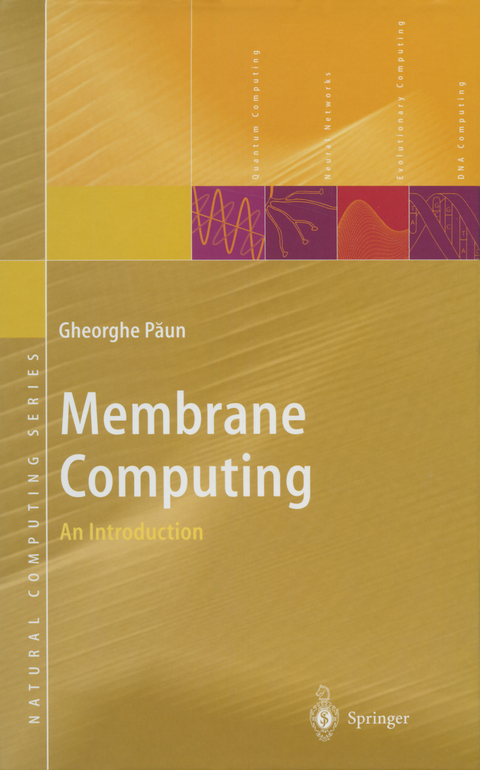
Membrane Computing
Springer Berlin (Verlag)
978-3-540-43601-0 (ISBN)
- Keine Verlagsinformationen verfügbar
- Artikel merken
This book is the first monograph surveying the new field in a systematic and coherent way. It presents the central notions and results: the main classes of P systems, the main results about their computational power and efficiency, a complete bibliography, and a series of open problems and research topics. Thus, the book is indispensible reading for anybody interested in molecular computing.
1. Introduction: Membrane Computing - What It Is and What It Is Not.- 2. Prerequisites.- 2.1 The Biological Membrane.- 2.2 The Neuron.- 2.3 Elements of Computability.- 2.4 Bibliographical Notes.- 3. Membrane Systems with Symbol-Objects.- 3.1 A Simple Class.- 3.2 Two Examples.- 3.3 The Power of the Simple Class.- 3.4 Basic Extensions.- 3.5 A Formal Definition.- 3.6 Further Extensions.- 3.7 Systems with External Output.- 3.8 Bibliographical Notes.- 4. Trading Evolution for Communication.- 4.1 Systems with Symport/Antiport.- 4.2 Computational Universality.- 4.3 Controls on the Use of Rules.- 4.4 Following the Traces of Objects.- 4.5 Systems with Carriers.- 4.6 Bibliographical Notes.- 5. Structuring the Objects.- 5.1 Rewriting Membrane Systems.- 5.2 Some Variants and Their Power.- 5.3 Splicing Membrane Systems.- 5.4 Contextual Membrane Systems.- 5.5 Insertion-Deletion Membrane Systems.- 5.6 Bibliographical Notes.- 6. Networks of Membranes.- 6.1 The Splicing Case.- 6.2 Using Symport/Antiport Rules.- 6.3 Neural-like Networks of Membranes.- 6.4 Bibliographical Notes.- 7. Trading Space for Time.- 7.1 Complexity Classes for Membrane Systems.- 7.2 Using Membrane Division.- 7.3 Using Membrane Creation.- 7.4 Using String Replication.- 7.5 Using Pre-computed Resources.- 7.6 Bibliographical Notes.- 8. Further Technical Results.- 8.1 Decidability Results.- 8.2 Unary Systems.- 8.3 A Representation of Context-free Languages.- 8.4 Valuating the String-Objects.- 8.5 Systems with Enhanced Membrane Handling.- 8.6 Brief Excursion Through the Literature.- 9. (Attempts to Get) Back to Reality.- 9.1 Getting Closer to the Cell by Energy Accounting.- 9.2 Getting Closer to the Cell by Gemmation.- 9.3 Getting Closer to the Cell: Bilayer Membranes.- 9.4 In Silico Implementations.- 9.5Artificial Life Applications.- 9.6 A Simulation of Photosynthesis.- Open Problems.- Universality Results.- References.
From the reviews:
"The subject of this book is the new computing model known as P-systems (honoring the initiator of the model who is the author of this book) and also as membrane systems. ... the book introduces complexity classes of problems that are suitable for membrane systems. It also provides many open problems in such membrane complexity theory. ... The book has extensive references, open problems and many ideas for further development." (Natasha Jonoska, Zentralblatt MATH, Vol. 1034, 2004)
| Erscheint lt. Verlag | 1.8.2002 |
|---|---|
| Reihe/Serie | Natural Computing Series |
| Zusatzinfo | XI, 420 p. 7 illus. |
| Verlagsort | Berlin |
| Sprache | englisch |
| Maße | 155 x 235 mm |
| Gewicht | 762 g |
| Themenwelt | Informatik ► Theorie / Studium ► Künstliche Intelligenz / Robotik |
| Technik ► Elektrotechnik / Energietechnik | |
| Schlagworte | Artificial Life • Biocomputing • Biologically Motivated Computing • Biology of the cell • Communication • Complexity • Computational Complexity • DNA computing • Evolution • extension • Künstliche Intelligenz • Membrane computing • Natural Computing • New Computing Paradigms • P systems • Simulation • Turing compatibiity |
| ISBN-10 | 3-540-43601-4 / 3540436014 |
| ISBN-13 | 978-3-540-43601-0 / 9783540436010 |
| Zustand | Neuware |
| Haben Sie eine Frage zum Produkt? |
aus dem Bereich


